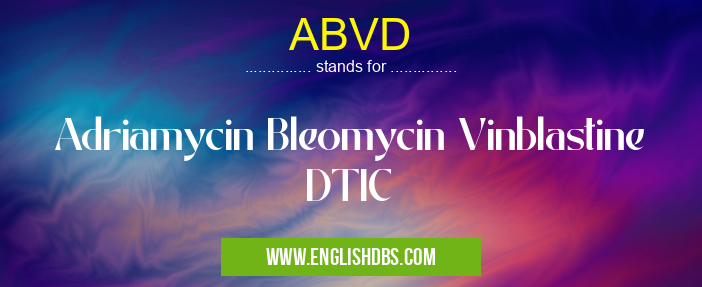What does ABVD mean in UNCLASSIFIED
ABVD is an abbreviation that stands for Adriamycin, Bleomycin, Vinblastine, and DTIC. It is a chemotherapy regimen used to treat various types of cancer, particularly Hodgkin lymphoma. This combination of drugs works by targeting cancer cells and inhibiting their growth and proliferation.

ABVD meaning in Unclassified in Miscellaneous
ABVD mostly used in an acronym Unclassified in Category Miscellaneous that means Adriamycin Bleomycin Vinblastine DTIC
Shorthand: ABVD,
Full Form: Adriamycin Bleomycin Vinblastine DTIC
For more information of "Adriamycin Bleomycin Vinblastine DTIC", see the section below.
Adriamycin (Doxorubicin)
- A type of anthracycline antibiotic
- Damages cancer cell DNA
- Commonly used in treating breast cancer, lung cancer, and leukemia
Bleomycin
- An antibiotic that inhibits DNA synthesis
- Causes DNA damage and cell death
- Effective against various types of cancer, including lung cancer, testicular cancer, and lymphoma
Vinblastine
- A vinca alkaloid that inhibits cell division
- Targets rapidly dividing cancer cells
- Used in treating Hodgkin lymphoma, breast cancer, and testicular cancer
DTIC (Dacarbazine)
- A purine analog that inhibits DNA synthesis
- Interferes with cell growth and replication
- Effective against melanoma, Hodgkin lymphoma, and soft tissue sarcomas
Essential Questions and Answers on Adriamycin Bleomycin Vinblastine DTIC in "MISCELLANEOUS»UNFILED"
What is ABVD?
ABVD is a chemotherapy regimen used to treat Hodgkin lymphoma, a type of blood cancer. It stands for Adriamycin, Bleomycin, Vinblastine, and DTIC.
How is ABVD administered?
ABVD is typically administered intravenously (IV) over a 2-week cycle. This is repeated for 6-8 cycles.
What are the side effects of ABVD?
The most common side effects of ABVD include nausea, vomiting, hair loss, fatigue, and low blood counts. Less common side effects include lung damage (from Bleomycin) and nerve damage (from Vinblastine).
How effective is ABVD?
ABVD is a very effective treatment for Hodgkin lymphoma. In most cases, it can achieve complete remission (no evidence of cancer).
What are the long-term risks associated with ABVD?
The long-term risks associated with ABVD include an increased risk of heart disease (from Adriamycin), lung damage (from Bleomycin), and leukemia (from DTIC).
What is the difference between ABVD and other Hodgkin lymphoma chemotherapy regimens?
ABVD is one of several chemotherapy regimens used to treat Hodgkin lymphoma. Other regimens include BEACOPP (Bleomycin, Etoposide, Adriamycin, Cyclophosphamide, Vincristine, Procarbazine, and Prednisone) and Stanford V (Vinblastine, Adriamycin, Cyclophosphamide, Vincristine, Mechlorethamine, Prednisone, and Bleomycin). The choice of regimen depends on the patient's age, overall health, and stage of cancer.
Final Words: ABVD is a widely used chemotherapy regimen known for its effectiveness in treating Hodgkin lymphoma. The combination of these four drugs targets different mechanisms within cancer cells, resulting in cell death and tumor regression. It is crucial to note that ABVD can have side effects, including nausea, fatigue, hair loss, and low blood counts, and should only be administered under the supervision of a qualified medical professional.
ABVD also stands for: |
| All stands for ABVD |
